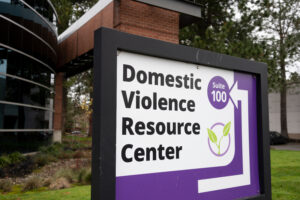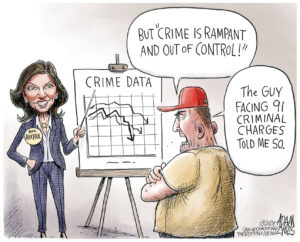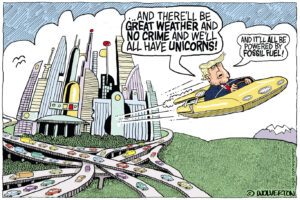Crime Is Way Down. Somebody Tell the NYT
If you say “many Americans are worried about crime,” then many Americans are going to worry about crime — even when it’s in a steady 30-year decline. Image: Adobe
Image: Adobe
In a piece factchecking Donald Trump’s claims in his acceptance speech at the 2024 Republican convention, the New York Times‘ Steven Rattner responded to Trump’s claim that “our crime rate is going up” by pointing out:
Crime has declined since Mr. Biden’s inauguration. The violent crime rate is now at its lowest point in more than four decades, and property crime is also at its lowest level in many decades.
The Times illustrated the point with this chart, which shows violent crime decreasing by 26 percent since President Joe Biden was inaugurated, and property crime going down 19 percent:

In a rational world, voters would be aware that crime went down sharply during the Biden/Harris administration, continuing a three-decade decline that has made the United States of 2024 far safer than the country was in 1991. To the extent that voters see national elected officials as responsible for crime rates, Biden and his vice president Kamala Harris would benefit politically from these trends.
But we don’t live in a rational world. So in the days after Harris became the apparent presidential nominee of the Democratic Party, she got a series of warnings from the New York Times.
“Today, many Americans are worried about crime,” David Leonhardt wrote in the Times‘ popular Morning newsletter. “Many voters are concerned about crime and public safety,” lawyer Nicole Allan wrote in a Times op-ed. “Ms. Harris, especially, will run into problems on immigration and crime,” Republican pollster Kristen Soltis Anderson wrote in another op-ed.
In none of these mentions did the Times‘ writers attempt to set the record straight on the actual crime situation in the country.
“Ms. Harris was a constant target last week at the Republican National Convention,” Jazmine Ulloa reported in a Times news story. “In panels and onstage, speakers tied her to an administration that they say has led to increases in crime and inflation.”
In none of these mentions did the Times‘ writers attempt to set the record straight on the actual crime situation in the country — that crime rates are low and heading lower. In the case of the news report, such an observation would likely be seen inside the Times as editorializing — a forbidden intervention into the political process.
But most people don’t get their ideas about how much crime there is by personal observation; with roughly 1 person in 300 victimized by violent crime over the course of a year, you would have to know an awful lot of people before you would get an accurate sense of whether crime was up or down based on asking your acquaintances.
As with immigration, and to a certain extent with the economy, people get the sense that crime is a crisis from the news outlets that they rely on. If they’re being told that “many Americans are worried about crime” — then many Americans are going to worry about crime.
Research assistance: Alefiya Presswala
Your support matters…Independent journalism is under threat and overshadowed by heavily funded mainstream media.
You can help level the playing field. Become a member.
Your tax-deductible contribution keeps us digging beneath the headlines to give you thought-provoking, investigative reporting and analysis that unearths what's really happening- without compromise.
Give today to support our courageous, independent journalists.








You need to be a supporter to comment.
There are currently no responses to this article.
Be the first to respond.